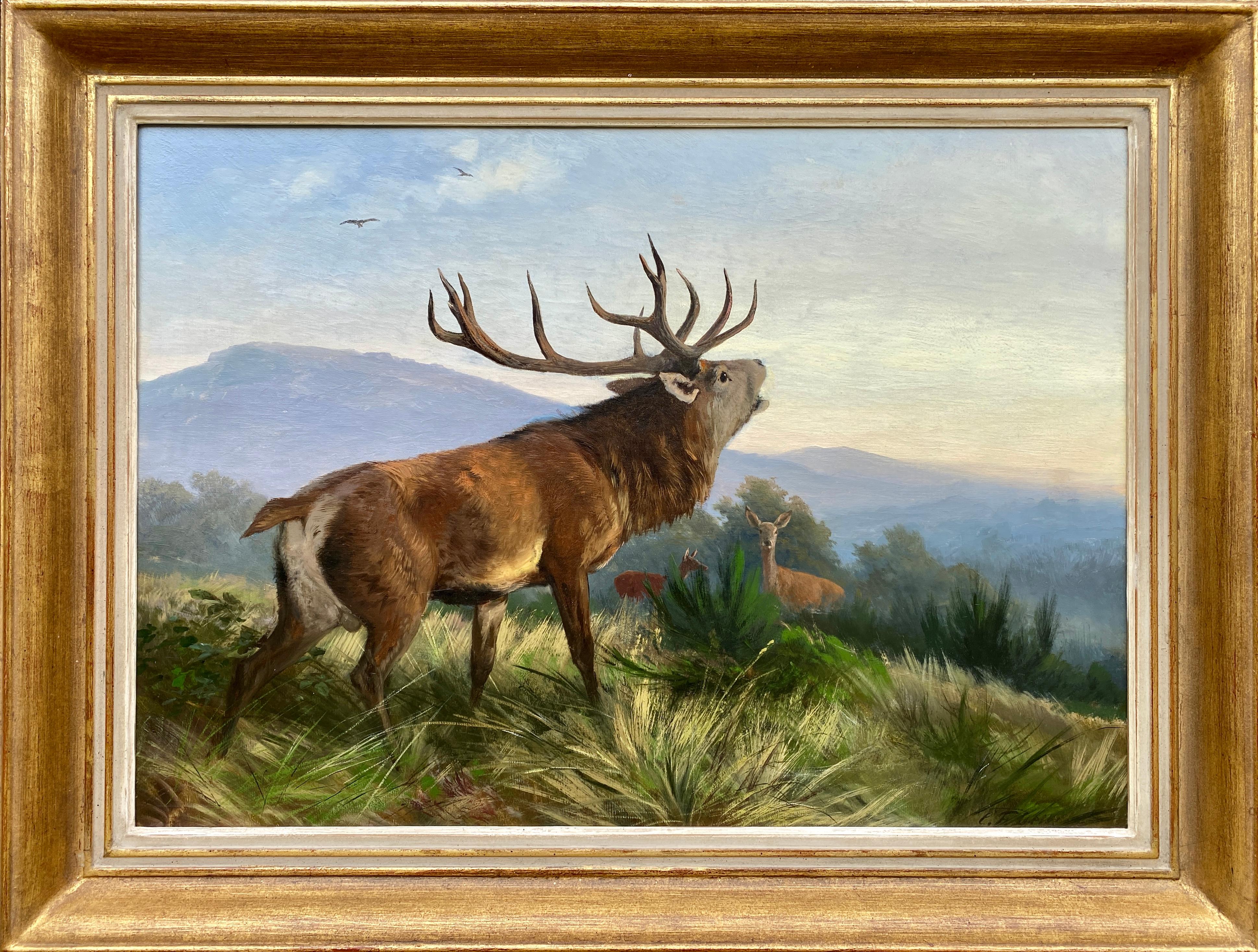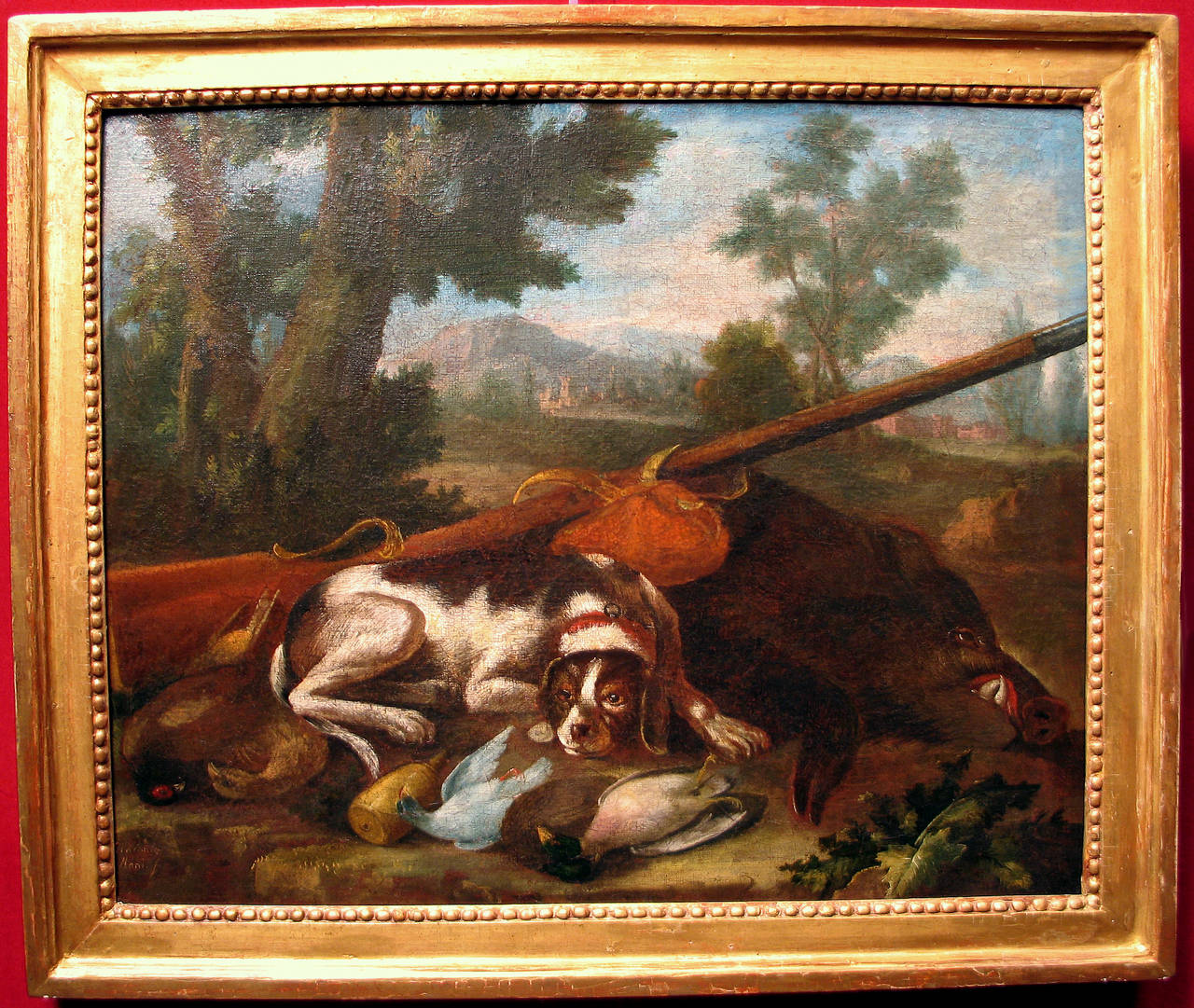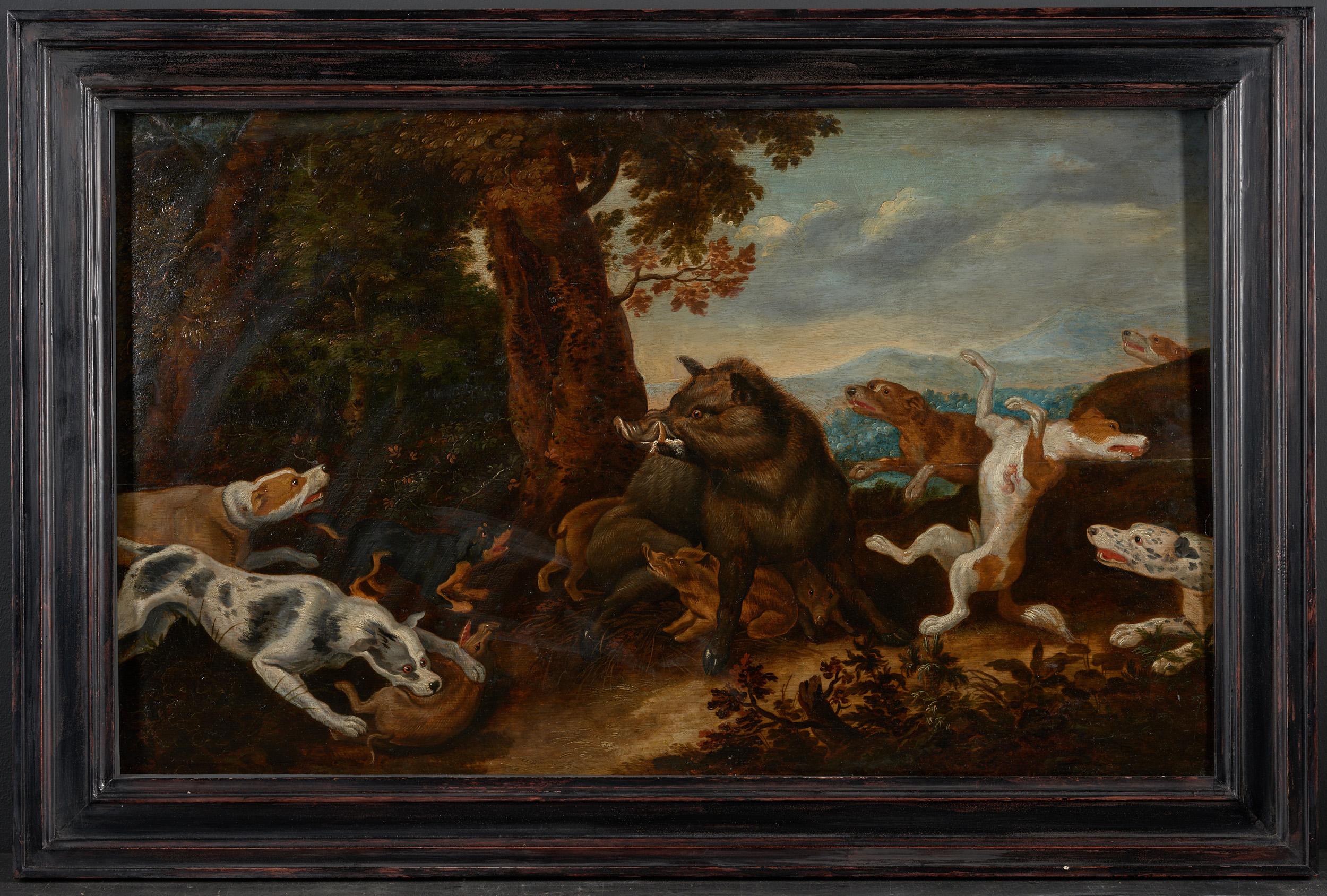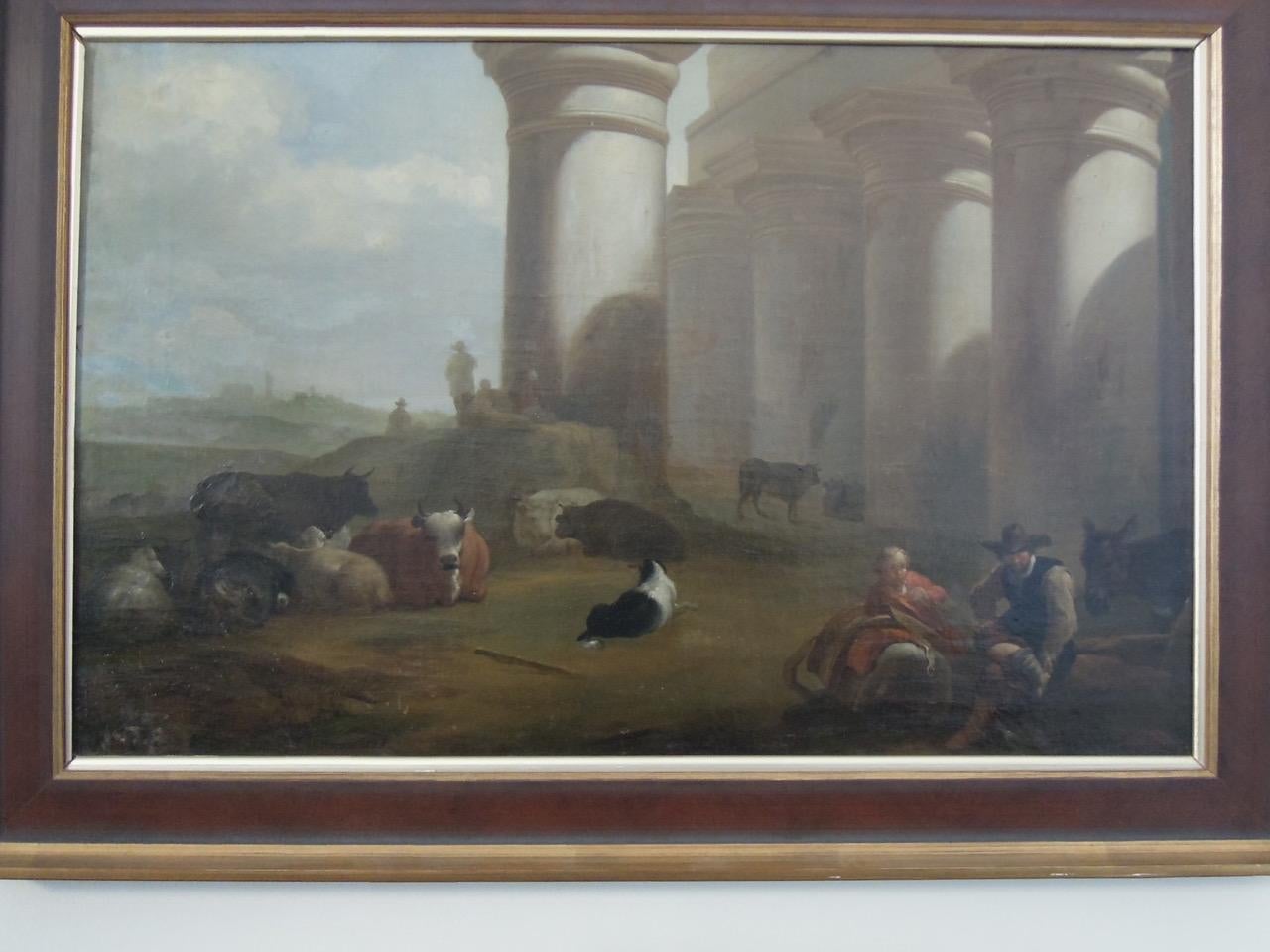Items Similar to Fine 1700's Italian Old Master Oil Painting Hunting Dogs with Game, Roman Ruins
Want more images or videos?
Request additional images or videos from the seller
1 of 11
Fine 1700's Italian Old Master Oil Painting Hunting Dogs with Game, Roman Ruins
About the Item
Artist/ School: Italian School, early 18th century
The painting is almost certainly from the circle of the Italian Baroque painter known as 'Rosa da Napoli', Jacob Roos (Rome 1682-Naples 1730), both stylistically and in terms of period and quality.
Jacob Roos is one of the best animalier painters active in Naples at the beginning of the eighteenth century. Our work reveals its aesthetic value and sensitivity to participate in that Rococo landscape for the modern, serene and Arcadian atmosphere. Jacob is the eldest son of Philip Peter Roos and participant in the workshop whose progenitor was Johann Henrich Roos. Born in Rome, he learned the art from his father (documented in Italy since 1680) and was influenced by the Capitoline landscape taste, according to a path similar to that carried out by Brandi, who De Dominici says was present in the Eternal City at a young age ( B. De Dominici, Lives of the Neapolitan painters, Naples 1742, III, pp. 560-65). The artist's catalog is still sparse, whose works reveal a refined narrative taste, with modulated light effects and a full-bodied and chromatically lively draft.
Title: The Hunting Party
Medium: oil on canvas, framed
Framed: 22 x 26.5 inches
Painting: 18 x 23 inches
Provenance: private collection, England
Condition: The painting is in overall very good and sound condition. It has a very old reline to the canvas and for its years is in very presentable condition. Frame is antique and has a few blemishes to the surface but nothing detrimental to its enjoyment and function.
- Dimensions:Height: 22 in (55.88 cm)Width: 26.5 in (67.31 cm)
- Medium:
- Movement & Style:
- Circle Of:circle of Jacob Roos (1682 - 1730, Italian)
- Period:
- Condition:
- Gallery Location:Cirencester, GB
- Reference Number:1stDibs: LU509311141442

About the Seller
5.0
Platinum Seller
These expertly vetted sellers are 1stDibs' most experienced sellers and are rated highest by our customers.
Established in 1989
1stDibs seller since 2016
3,433 sales on 1stDibs
Typical response time: 2 hours
- ShippingRetrieving quote...Ships From: Cirencester, United Kingdom
- Return PolicyA return for this item may be initiated within 3 days of delivery.
More From This SellerView All
- 1930's Oil Painting Cow In Grey Gloomy Meadow LandscapeLocated in Cirencester, GloucestershireMeadow Landscape signed by Y. Blanchon, French 1950's Impressionist artist oil on artist paper, unframed painting: 16.5 x 13 inches provenance: from a large private collection of th...Category
Mid-20th Century Impressionist Landscape Paintings
MaterialsOil
- Large British Hunting Scene Signed Oil Painting Huntsman, Horses Hounds & FoxLocated in Cirencester, GloucestershireArtist/ School: John Munnings (1916-1987), signed lower front and labelled verso. John Munnings (1916-1987) was the nephew of the famous equestrian artist Sir Alfred J. Munnings. He was born at Mendham Mill, Suffolk, and wrote a book full of fascinating reminiscences about his childhood at the mill. Munnings fought in the Second World War and was held a prisoner of war. After the war he married and became manager of an agricultural firm. He was a keen artist, giving exhibitions at the Assembly Rooms, Norwich and combined this with his interest in watermills to produce the many sketches of mills, now in the archives in museums and private collections. Title: 'The One That Got Away...Category
Mid-20th Century Victorian Landscape Paintings
MaterialsOil
- Antique British Hunting Scene Oil Painting - Huntsman on Horseback in LandscapeLocated in Cirencester, GloucestershireArtist/ School: E. S. England (British, active c. 1890-1910), signed lower corner. Title: The Huntsman and his horse. Medium: signed oil painting on canvas, unframed. canvas: ...Category
Late 19th Century Victorian Landscape Paintings
MaterialsOil
- Bengal Tiger Huge Oil Painting on Canvas after George StubbsLocated in Cirencester, GloucestershireThe Tiger British School, circa 1980's after George Stubbs, c.1760 oil painting on canvas, framed framed: 26 x 50 inches Stunning oil painting on canvas, painted on a huge scale (t...Category
Late 20th Century Realist Animal Paintings
MaterialsOil
- Fine Dog Portrait of a Setter standing in a Landscape, French School workLocated in Cirencester, GloucestershireArtist/ School: French School, contemporary Title: Setter (?) Dog in a Landscape Medium: oil painting on canvas, unframed, signed canvas: 20 x 24 inch...Category
21st Century and Contemporary Victorian Animal Paintings
MaterialsOil
- Scottish Oil Painting Black Grouse in a Tree within a Highland LandscapeLocated in Cirencester, GloucestershireArtist/ School: Early 20th Century Scottish School Title: A black grouse in a tree Medium: oil painting on board, framed, signed Painting: 18 x 14 i...Category
20th Century Victorian Animal Paintings
MaterialsOil
You May Also Like
- Van der Bent, Southern Landscape with woman animals, Dutch Old Master, BerchemLocated in Greven, DE17th Century Old Master, Figurative and Landscape Painting by Jan Van der Bent So far, little is known about the life and work of Jan van der Bent. He was...Category
17th Century Baroque Landscape Paintings
MaterialsCanvas, Oil
- Roaring Deer Stag, Carl Friedrich Deiker, Wetzlar 1836 – 1892 Düsseldorf, SignedLocated in Bruges, BERoaring Deer Stag Deiker Carl Friedrich Wetzlar, Germany 1836 – 1892 Dusseldorf, Germany German Painter Signature: Signed bottom right Medium: Oil on canvas Dimensions: Image size 58 x 81 cm, frame size 73 x 96 cm Biography: Deiker Carl Friedrich was born on April 3, 1836 in Wetzlar. He was a Prussian animal painter. Deiker was specialised in animal genres related to hunting and wildlife. He also illustrated magazines and books on hunting. Carl Friedrich Deiker was the son of Friedrich Deiker, a painter and drawing teacher at the high school. His older brother, Johannes Deiker, with whom he learned to draw after their father’s death in 1843, was a painter specialising in hunting scenes. Deiker attended the Hanau drawing Academy, where he was a pupil of the director Theodor Pélissier (1794-1863), and then studied at Johann Wilhelm Schirmer’s studio in Carlsruhe. In 1859, in the Reinhardswald forest, he collected studies for his large hunting paintings...Category
19th Century Baroque Animal Paintings
MaterialsCanvas, Oil
- Hunting Dog with GameBy Giacomo NaniLocated in Atlanta, GAFamous for his paintings of animals, landscapes and still lifes, Giacomo (sometimes spelled Jacopo) Nani was an Italian painter of the Baroque period. Presumably born in Naples, Nani studied under Gasparo López and Andrea Belvedere whose style Nani often imitated. Nani became famous while working in the court of Charles of Bourbon, future Charles III of Spain (1716 – 1788). His work is featured in the collections of museums worldwide, especially his hometown museum in Naples. An excellent example of his work, this painting is signed in the lower left corner "Giacomo Nani." This painting depicts a hunting dog...Category
18th Century and Earlier Baroque Animal Paintings
MaterialsCanvas, Oil
- Flemish 17th, Orpheus and Animals, Large Decorative Wall Old Master PaintingLocated in Greven, DEFlemish school, 17th century Orpheus and the animals Oil on canvas, 146,5 x 217 cm Provenance: South German private collection. On an impressive, room-filling format, this painting depicts "Orpheus and the Animals." The harp-playing Orpheus sits centrally in front of a tree whose trunk bifurcates above his head. This central tree frames with its crown the scenery towards the horizon and at the same time offers through branches the possibility for many birds to find space. The left half of the picture is characterized by a seascape, at the edge of which the ruins of a castle can be seen deep in the background. This seascape, framed by mountains on the horizon, is the only area where sky can be seen. On this side, waterfowl such as storks, swans and ducks can be seen. In the right half, the viewer looks into a deep European forest. On this right side, more land animals can be found, such as deer, rabbits and lions, among others. Orpheus wears opulent red and gold trimmed clothing, under his blue breastplate we see a white shirt. His feet are adorned by elaborate sandals. His head is surrounded by a radiant laurel wreath ("poeta laureatus"). The young man is clearly identifiable as the singer and poet of Greek mythology, Orpheus, by his harp, the laurel wreath and the animals surrounding him. Orpheus was one of the Argonauts who, under Jason, was searching for the Golden Fleece. He sang so beautifully that he even conquered the angry sea and enemies by the magic of his lyre. During the journey, Orpheus is said to have drowned out even the sirens with his singing. It is said that he was the greatest of all poets and charmed people, animals, stones and trees with his singing. In total, 51 birds and 37 different species are depicted in the painting. The animals are mostly depicted in great detail and, except for a few, can be identified. Mainly European species of animals are shown. Exceptions are the ostrich-like nandu peeking out from behind the deer, as well as the large parrot on the upper left, and the two lions. Similar is the case for the large animal directly behind Orpheus on the right. The shape of the head suggests an arctic fox from the polar regions, even though the body is much too large. The arctic fox was first described in 1555 by Olaus Magnus. However, it could also be a depiction of a brown or black bear. An unusual detail is the animal, which is relatively isolated in the right background and looks to the left. It is not clearly identifiable, but it shows certain similarities with the Australian kangaroo. This was first described by Vespucci in 1500 and further by Francisco Pelsaert in 1629. If it is indeed a kangaroo, this would be one of the earliest surviving pictorial representations. In this painting, Orpheus is accompanied by a small monkey playing a viola da gamba. This is an iconographic peculiarity. In general, this painting has some peculiarities compared to other paintings with "Orpheus and the animals". The central positioning of Orpheus is quite common, but he usually holds a lyre and is dressed in an antique style, but not as opulently. The choice of animals is also remarkable: European animals in particular are seen, hardly any exotic features, such as camels or elephants. The two lions in the right foreground are a quotation from Peter Paul Rubens and his depiction of "Daniel in the Lion's Den", which was realized in an engraving. The present painting can be classified as belonging to the Flemish School of the 17th century on the basis of its painterly and compositional conception. From the circle of Jan Brueghel the Younger are numerous representations of this Orpheus - theme, which take it as an opportunity to show as many exotic animals. There are also echoes of Spanish painters such as Juan de Arellano...Category
17th Century Baroque Landscape Paintings
MaterialsOil, Canvas
- 17th C, Baroque, Hunting Scene, Wild Boar Hunt in the style of Frans SnijdersLocated in brussel, BEHunting played an essential role in the lives of princes and nobles for centuries. It was no different in the 17th century. Paintings depicting hunting scenes were hung, for example, in the hunting lodges of elites. It should be noted that the upper bourgeoisie also began to show interest in painted hunting scenes during the 17th century. In the Southern Netherlands there were a number of skilled animal painters who produced hunting scenes, including Frans Snijders, Paul De Vos, Jan Roos, Pieter Boel and Jan Fyt. Snijders knew how to render the anatomy of the animals masterfully. Also, he managed to make his animals look intelligent. He let them express a variety of feelings. His colleague, Paul De Vos, seems to have been less familiar with animal anatomy. His animals lack a kind of individuality and psychological expression. The panel shows a boar hunt with dogs. It was a prevalent theme, portrayed by Rubens, Snijders, De Vos and others. Buyers were especially interested in the showdown between animal species. The mental and physical strength appealed to their imagination. The painter of this little work has no solid knowledge of dog breeds. Due to a lack of insight into dogs' bone and muscle structure, he makes them look rather stiff. Mainly the heads have something naïve about them. It cannot be ruled out that the artist of this painting is Jan van Kessel...Category
17th Century Baroque Landscape Paintings
MaterialsCanvas, Oak, Oil
- Southern Landscape with Cows, circle of Both, Dutch 17th Century Old MasterBy Jan Dirksz BothLocated in Greven, DECircle of Andries Both, Southern Landscape with Cows. Both moved to Italy ( Rome and Venice) where is work was influenced by the warm Italian light. Decorative PaintingCategory
17th Century Baroque Animal Paintings
MaterialsCanvas
Recently Viewed
View AllMore Ways To Browse
The Hunting
Antique Circle
Antique Circles
Italian Old Masters
Italian Old Master
Best Of 22
Oil Painting Circle
Antique Old Painting
Antique Old Masters
Antique Painting Of Italy
Modern Art Painting Circles
Baroque Oil Painting
Roman Fine Art
Painting Of Naples
England Roman
Oil Paintings Game
Jacob Fine
Oil Paintings Of Game





